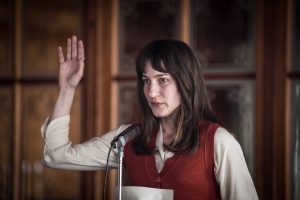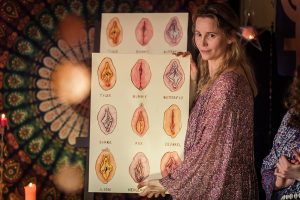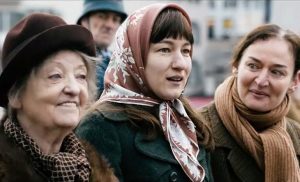The Divine Order
“The Divine Order”: Voting Rights for Women in Switzerland
by Amanda Staab
“In 1971, the world was changing. But here at home, time stood still” (Volpe).
Introduction

The 2017 film “The Divine Order“, or “Die Göttliche Ordnung“, centers around women’s voting rights in Switzerland in the 1970s. Swiss women didn’t gain the right to vote until 1971, much later than surrounding countries. In fact, Switzerland was the second to last European country to grant women the right to vote, behind only Lichtenstein in 1984.
I was introduced to this film in my German class last Spring. While we watched this movie to acquire a sense of the Swiss-German dialect (a nearly altogether different language from German), this film left a lasting impression on me for other reasons.
Before watching this film, I had never learned anything about Switzerland’s monumentally late women’s suffrage. This troubled me. I began to realize that I only had knowledge concerning the suffrage of American women.
This movie serves as a wake-up call to those of us who see only the development of the rights of women in the place where we live. It combines Swiss nationality, sexuality, women’s roles, and suffrage, providing an excellent example of intersectionality in the area of women’s and gender studies.
Important Vocabulary
Canton – subdivision of a country
Frauenstimmrecht – (German) women’s right to vote
Intersectionality – framework of how aspects of identities (including race, class, gender) are interconnected and overlap to foster discrimination/disadvantage
Liberation – the act of setting someone free
Referendum – a direct and universal vote in which all people in given country/area are asked to vote on a certain proposal
Suffrage – the right to vote in political elections
The divine order – the law of the omnipresent; the natural structure
Movie Summary

Image A: Nora, the movie’s protagonist
I hate to give the movie away, but we already know that women gain the right to vote in Switzerland (thank God). So I suppose I can’t really spoil that.
The film opens with a pan of beautiful Swiss mountains and charming villages juxtaposed with scenes of the Civil Rights Movement, the “Hippie” Movement, Woodstock, and the Sexual Revolution in America. The main character Nora says, “In 1971, the world was changing. But here at home, time stood still” (Volpe). The viewer gains a sense of the contrast between Switzerland and the “outside” world.
Nora is a housewife with a handsome husband, Hans, and two young sons. She lives with them and her husband’s extended family. We see her hard at work – cooking, cleaning, catering to the needs of the males in the household. Bored of this life, Nora politefully laments that she tires of housework and suggests to Hans that she would like to go back to work for some variety. He does not like this idea. And, in Hans’ words, “[She] can’t do it without my permission anyways. That is the law” (Volpe). Sweeping Nora up, he suggests that if she is bored, they should make another baby.
Whilst walking in her village, Nora is approached by a woman handing out flyers for women’s rights. Nora asserts, “ I don’t need to be liberated” (Volpe) but takes them anyway. That night, she stays up into the morning reading the pamphlets. Her opinion begins to shift. She sets about on a path towards women’s liberation and the right to vote. Nora meets some strong women of the same opinion and they decide to organize an event to educate her village.
Nora attends a clinic with her new friends. Their sexual shyness shines through when the speaker begins to inform the women about the vagina as a form of sexual liberation. Nora takes a curious first look at her own and utters, “A tiger” in response to the chart of different vagina shapes. She realizes that she has never had an orgasm.
The day of the village event comes and it is a failure. Her husband is mortified and all the women present are too nervous to stand up for their rights in front of their husbands and their village. One woman in particular, Dr. Wipf, is adamantly against rights for women. She claims, “Emancipation is, in reality, a curse for us women…Women in politics are simply against the Divine Order” (Volpe). Later, when Nora speaks to the other women, they admit that they indeed desire the right to vote but are afraid.
The women of the village organize a strike, leaving their husbands to care for the cooking, cleaning, and children. Hans meets resistance from his male counterparts. He is criticized for not “controlling” his wife and for allowing her to give other wives such a dangerous idea. Hans considers separating from Nora.
They later make up when Nora stands up for a woman at her funeral and Hans is finally able to see the strength of his wife. The referendum to give women the right to vote passes, much to the elation of Nora, her friends, and Hans. The movie ends with Nora and Hans in bed as he finally pays attention to her needs. It is their own “sexual revolution.”
Women’s right to vote in Switzerland
 Image B: Nora and her husband Hans as Nora turns in her first ballot
Image B: Nora and her husband Hans as Nora turns in her first ballot
This movie highlights the 1971 referendum, which gave women the right to vote in national referendums and in elections for the lower house of parliament. But even after its success in 1971, the fight for the right to vote was far from over.
Switzerland’s first women’s suffrage organization devoted exclusively to women’s rights came about in 1893. Still, public discussions of this topic were rare. In the early 1900s, there was lots of motion but too much dependency on specific leaders and not enough widespread support. Many women did not endorse “too” much suffrage for themselves (Banaszak). The period of the economic depression and Second World War stagnated the movement. The government was concerned with other things. But after, interest in suffrage again piqued. 1959 held a victory and a defeat for the country, as the first national vote was rejected. Protests and strikes followed this decision. However, a cantonal vote passed in both Vaud and Neuchâtel that same year. The 1971 referendum passed on February 7th. 66% of men voted for the women’s vote. It was a victory for the country as a whole. Still, 10 cantons hadn’t yet approved the women’s vote on a cantonal level. Appenzell Innerrhoden, the final canton, didn’t give in until 1991. So even after the victory portrayed in this movie, female voting rights were far from country-wide.
The Sexual Revolution
 Image C: The clinic leader holds a poster featuring different types of vaginas
Image C: The clinic leader holds a poster featuring different types of vaginas
What Nora gained from Sexual Revolution-based ideas was nothing radical. She was not LGBTQ+, nor did she want to engage sexually with many different partners, nor did she seek an abortion or “The Pill.” Rather, she gained the understanding that she, as a woman, should enjoy sex as much as her husband. She learned that it was as much for her as it was for him. This idea was not so groundbreaking as the other ideas the sexual revolution was unleashing. But for her? Groundbreaking indeed.
In America, the Sexual Revolution took place throughout the entire decade of the 1960s. The movement made sex more acceptable outside of heterosexual marriage, brought attention to gay rights, tackled issues of abortion and contraception, and promoted the absurd idea that women should enjoy the act of sex.
This same Sexual Revolution did reach Switzerland. However, like other movements of the time, it took longer to get there and was a bit more subdued. It is documented as occurring in 1968, just years before the 1971 referendum. The elements of this movement were similar to that of their American counterpart. One author writes, “Women started to act as men had before…It seems that beforehand, women were supposed to stay in the shadow of a man and be happy with such a role” (Lohman).
Connections to Feminist Texts
 Image D: Nora (center) with her two friends who are fighting alongside her for voting rights
Image D: Nora (center) with her two friends who are fighting alongside her for voting rights
Many themes present in this film are topics of discussion in the feminist world. The following texts support and build off of the film in a powerful way.
Two feminist authors, Jennifer Baumgardner and bell hooks, review the history of sexual pleasure and present their findings in articles and books they have written. hooks claims that, “We are taught that the domain of sexual pleasure is male” (hooks). These women write to inform that women deserve sexual pleasure and that such gratification is often not derived from penetration (Baumgardner). It took Nora half of her life to learn this information – information that should be widely known and readily accepted.
We see the sexist roles of the sperm and the egg come to life when Hans suggests “putting a baby” in Nora. This suggests a passive term for the egg and active term for the sperm – a description often found in scientific explanations of conception. Emily Martin’s “The Egg and the Sperm” shines light on this sexist bestowing of personalities on cells. She writes, “Evidence shows that egg and sperm do interact on more mutual terms, making biology’s refusal to portray them that way all the more disturbing” (Martin). Yet still, the egg is likened to sleeping beauty, waiting to be awoken by the strong, powerful sperm (Martin).
In Adrienne Rich’s piece, “Claiming an Education,” one cannot help but draw parallels between claiming an education and claiming a right to vote, a right to work, and a right to be considered a person in the eyes of politics. She writes, “Our upbringing as women has so often told us that [taking responsibility towards yourselves] should come second to our relationships and responsibilities to other people” (Rich). In writing this, Adrienne speaks directly to women like Nora who need to understand that “claiming” something as important as this is not selfish (even though her husband argued the contrary). Rather, it is a responsibility. It is something she owes herself, nothing less.
Conclusion
Although less radical than some feminist texts, I believe “The Divine Order” conveys a message of vast importance. Voting rights was a stepping stone for women to political personhood. It is important that we acknowledge this not only in our own country but in all countries. Swiss nationality, sexuality, women’s roles, and suffrage are all woven into this story, making it an intersectional work of feminist literature. We know now that men should not say, “Women must remain quiet. That’s what it says in the bible” or, “She knows where she belongs” (Volpe). Still, it is important to remember a time and a place where these phrases wouldn’t elicit a single bat of the eye. We are working towards change. To continue to foster this change, we must not forget ideas of the past and how we overcame them.
Works Cited
Banaszak, Lee Ann. Why Movements Succeed or Fail : Opportunity, Culture, and the Struggle for Woman
Suffrage. Princeton University Press, 2001.
Baumgardner, Jennifer. “What is Bisexuality?” Women’s Voices, Feminist Visions: Classic and
Contemporary Readings, edited by Susan Shaw and Janet Lee, Mc-Graw Hill, 2012, 189-195.
Falk, Francesca. Gender Innovation and Migration in Switzerland. Springer International Publishing,
2019, doi:10.1007/978-3-030-01626-5.
hooks, bell. Feminism Is for Everybody : Passionate Politics. [Second edition]., Routledge, 2015.
Lohman, Pierce. Did the Sexual Revolution of 1968 influence Women’s Political Emancipation in
Switzerland? Maastricht University, E-International Relations, 2011.
Martin, Emily. “The Egg and the Sperm: How Science Has Constructed a Romance Based on
Stereotypical Male-Female Roles.” Signs: Journal of Women in Culture and Society, vol. 16, no.
3, Apr. 1991, pp. 485–485, doi:10.1086/494680.
Rich, Adirenne. “Claiming an Education.” Douglass College Convocation, 1977, New Brunswick, NJ.
Speech.
Volpe, Petra Biondina, et al. Die göttliche Ordnung = The divine order. Zeitgeist Films, 2018.